Packing for any trip is hard but packing to move abroad into
an unknown situation is even harder. I
have been in this position several times but never like this. Everything I need
needs to fit into two pages that weight less that 50 pounds. I decided that I would be taking one large
duffle and my hard sided trunk.
I had to shrink 22 years’ worth of stuff down to 100 pounds
or less. It was amazing to see how much stuff I had acquired just over the 4.5
years of college. I had to sort through
it and decide if I was going to keep, trash or donate it. I spent several days sorting that and
condensing two rooms’ worth of stuff down to one room that is semi-organized.
For those who know me, I mostly where T-shirts and never really
thought about how many T-shirts I actually had.
I had stopped buying T-shirts at places but that did nothing to slow
down my collection. During the laundry
short, I discovered that I had over 75 t-shirts. I went though and if they were from high school
they immediately went to the goodwill pile, from there the ratty shirts were
made into rags. That got right of about
a third of them.
Back to packing, I was hired as an International Mobile
Employee with an emphasis on the mobile part.
SLB works in over 90 counties and I could be sent to work in about 80 of
them. The ones I can’t are for the being
female issues or the being a US citizen. Currently I am working 4 degrees above
the equator but there is nothing stopping me from going on load to North Sea. This makes packing hard because I had to
decide what types of clothing and how much clothing of each type to bring.
In the end, I decided that I would focus on the warm weather
gear. For the most part it was light
weight clothing for work and my time off.
I threw in a jacket for air conditioned buildings but the rest of my
beloved jacket collection stayed in my room in the United States. I packed enough clothing for about a week and
half between doing laundry as well as some clothing for hiking and going
out. I also threw in my sleeping bag,
hiking boots, and trekking poles. After
that I was left with what other entertainment items did I want to bring. I bought a kindle paperwhite so that had
reading materials covered, other than that I brought my DVD collection, and my
personal laptop.








